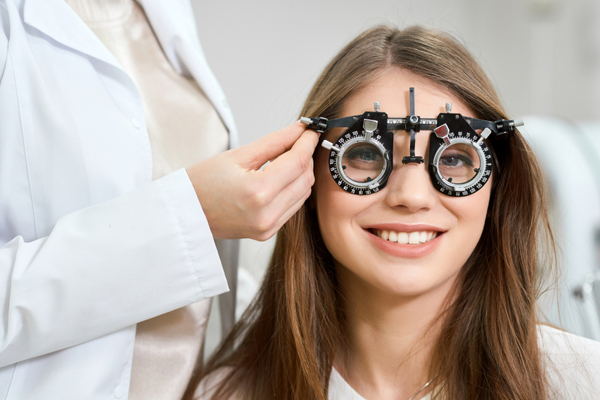Ask an Optometrist: Symptoms and Causes of Keratoconus

Keratoconus is an eye disorder that develops when the cornea thins and bulges outward, taking a cone shape. The cornea is the clear front surface of an eye, and it usually has a dome shape. The cornea losing its proper dome form and becoming shaped like a cone leads to increased sensitivity to light and blurred vision.
Keratoconus typically affects both eyes simultaneously. The problems often start around the ages of 10 to 25, and their progression is often slow for the first decade.
People dealing with the early stages of keratoconus can usually correct their vision issues with soft contact lenses or glasses. Scleral and rigid gas permeable contact lenses can be used as their condition worsens, while those with advanced keratoconus might need a cornea transplant. Corneal collagen cross-linking can help stop or slow down the progression of the disease.
The advanced stages of keratoconus can lead to fluid build-up in the cornea, leading to swelling in the eye. It can also cause scarring that worsens a patient's vision. A cornea transplant is typically needed at this point.
Symptoms and causes of keratoconus
The exact causes of keratoconus are unknown, but some environmental and genetic factors that might contribute to the condition have been identified. These include:
- Genetics: About one out of every 10 people with keratoconus have a parent with the condition
- Rubbing the eye vigorously: This damages the cornea and thins it out
- Health conditions: Asthma, hay fever, and down syndrome increase a person's risk of developing keratoconus
- Inflammation: Inflammation caused by issues like eye disorders, allergies, or asthma can damage the cornea, leading to keratoconus
- Age: Teenagers and young adults are most likely to develop keratoconus. It rarely affects people over the age of 40
The symptoms of keratoconus typically change as the disease progresses. Some of the more common ones include:
- Increased sensitivity to glare and light, leading to difficulty driving at night
- Frequently having to change eyewear prescriptions
- Cloudy vision that worsens with time
- Distorted or blurred vision
Anyone with a combination of these symptoms should head to an optometrist for an examination. Some of the tests used to diagnose the condition include:
- Eye refraction: This involves using tools to detect vision issues. The patient is asked to look through a device that contains a wheel made up of different lenses. The device is called a phoropter, and it is used to evaluate how well the patient sees. Hand tools like a retinoscope might also be used during this test
- Slit-lamp exam: This involves directing a vertical light beam on the surface of the patient's eyes. A microscope is then used to evaluate the shape of the person's cornea while looking for other abnormalities in the eye
- Keratometry: During this test, a circular light is focused on the patient's cornea to measure how it reflects light. This can be used to determine its shape
- Computerized corneal mapping: This includes tests like corneal topography and tomography. These tests use images to create a detailed shape map of the patient's cornea. Corneal tomography can be used to diagnose the early stages of keratoconus more effectively than the other tests
The optometrist will also talk to patients about their family medical history and any risk factors that might be contributing to the patient's condition. Once keratoconus has been determined to be the cause of the patient's vision problems, treatment options that might be recommended include:
Corrective lenses
Keratoconus treatments typically aim to slow down the condition's progression and improve the patient's vision. Corrective lenses are a non-invasive, effective way to address the vision problems created by keratoconus.
Soft contact lenses and eyeglasses are used to correct the distorted or blurry vision keratoconus causes in its early changes. However, people with the disease might need to change their prescriptions frequently due to the changes taking place in their cornea.
Some patients might have to switch to hard contact lenses as their condition worsens. Many people find these lenses uncomfortable when they first start wearing them but eventually adjust to them. These lenses can be made to fit on the cornea, leading to excellent vision. Patients who struggle with rigid contact lenses can have their optometrist place one on top of a soft lens to make it more comfortable. Hybrid lenses can also help with advanced keratoconus. Scleral lenses are typically recommended for the most advanced stages of the disease.
Surgery
Cornea transplants might be needed to treat advanced keratoconus. These treatments are used as a last resort when corrective lenses fail to improve the patient's vision or issues like corneal scarring are present.
We are here to help
Our optometrist has lots of experience helping patients with keratoconus. Call or stop by our Mt Vernon clinic to set up an appointment.
Request an appointment here: https://brighteyesmv.com or call Bright Eyes Optometry at (914) 668-1429 for an appointment in our Mt Vernon office.
Check out what others are saying about our services on Yelp: Keratoconus in Mt Vernon, NY.
Recent Posts
Emergency eye care is needed if you find yourself dealing with a problem with your eye that causes pain or affects your vision. Failing to treat eye injuries as soon as they are detected can lead to permanent consequences, like reduced vision or blindness. Common eye injuries that require emergency eye care include: Exposure to…
Looking for more information on eye protection? An ophthalmologist knows everything there is to know about protecting the eyes. While there are a few different types of eye care professionals, ophthalmologists are eye care professionals who have undergone additional years of education and training so they can offer their patients both medical and surgical eye…
Controlling myopia at an early age can slow down its progression. This can help prevent yearly upgrades for stronger glasses. Your optometrist can help by offering various treatments. If you want to find out how your optometrist can help control myopia, here are the details.Optometrists use atropine eye drops to achieve short-term myopia control results.…
Another word for an itchy eye is ocular pruritis. It is a common health situation in many people. Itchiness in your eyes is more than enough reason to see an optometrist. Receiving prompt treatment is important in receiving prompt relief. If you want to know what causes an itchy eye and the treatments for it,…



